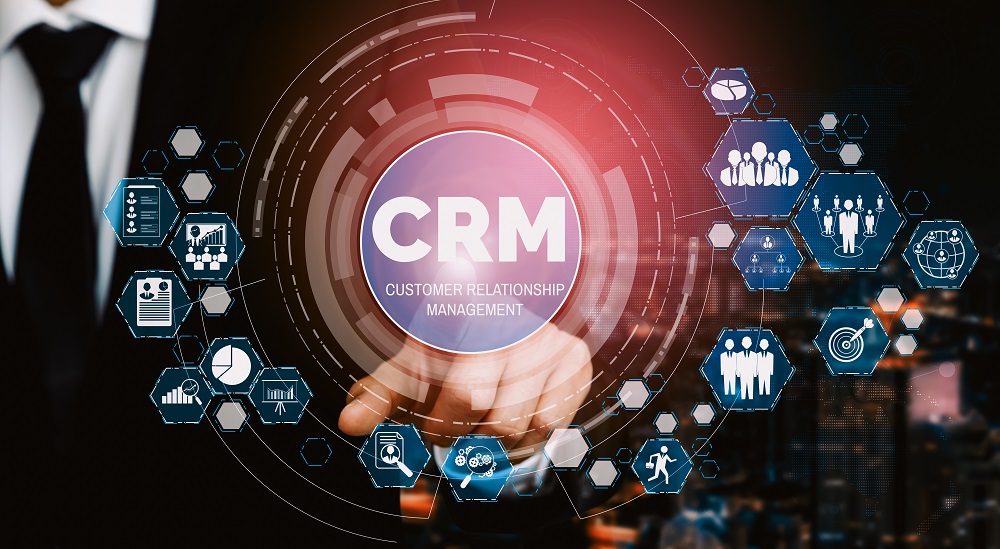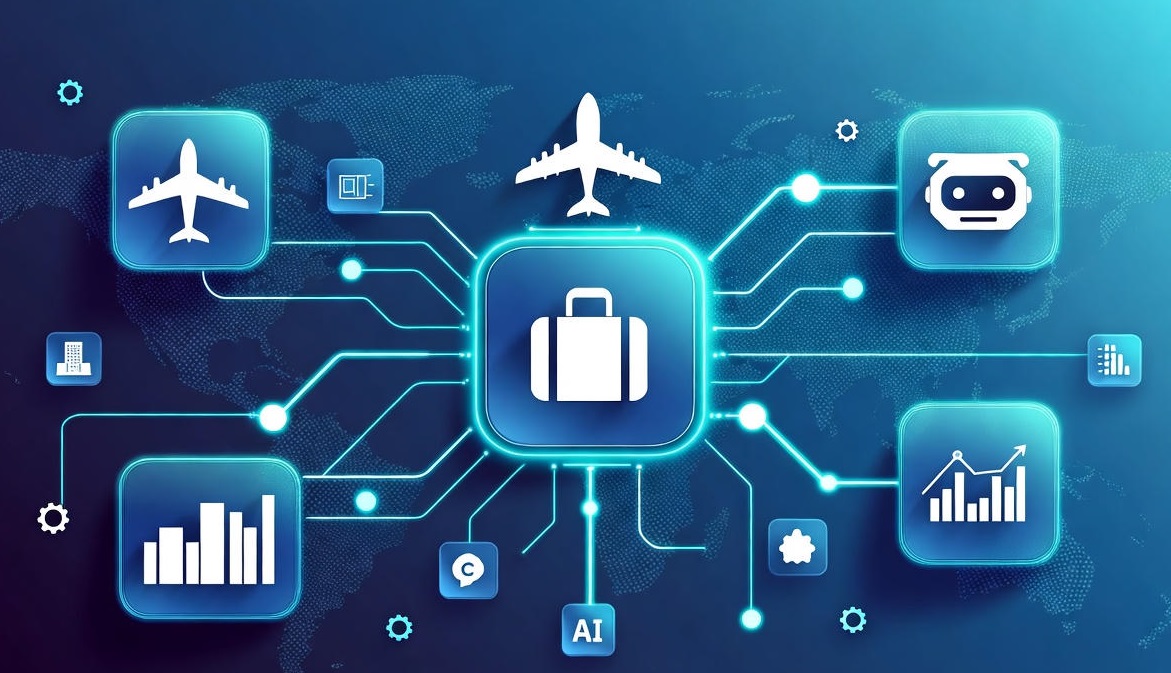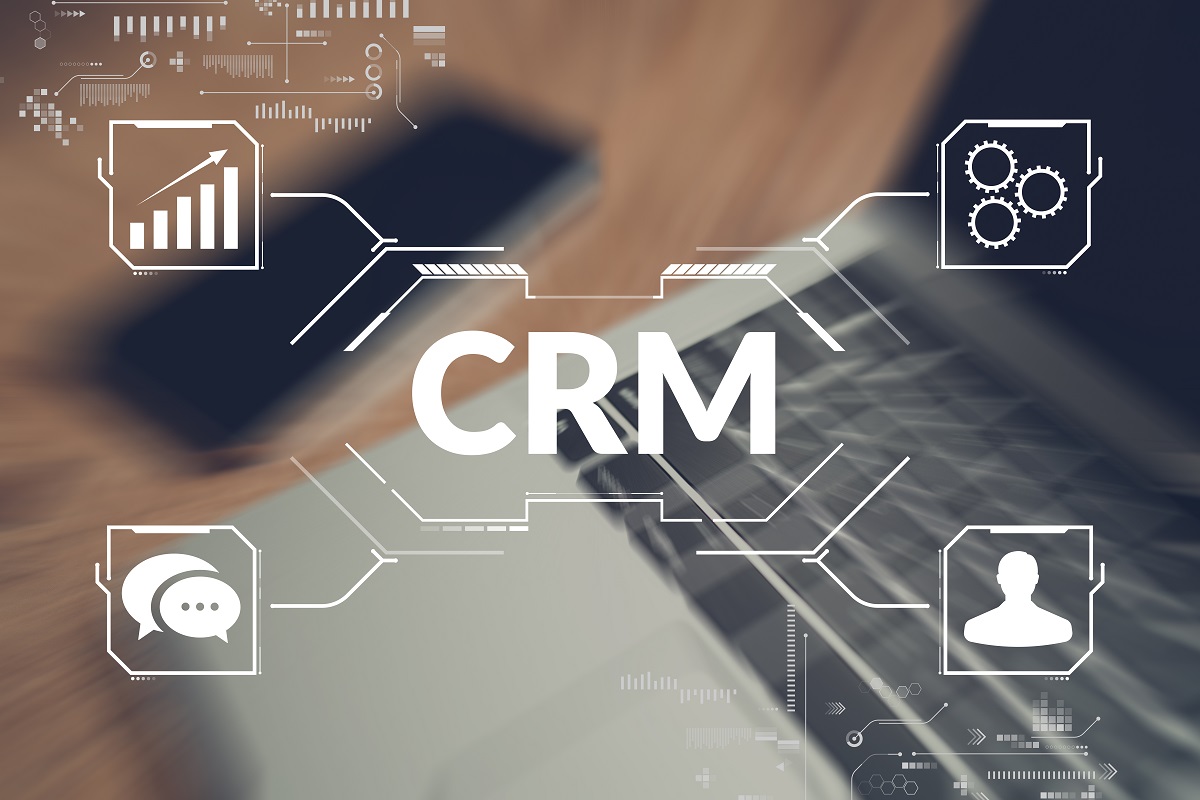Latest Blog

AI-Enhanced CRM: Driving Growth Through Smart Automation
Customer Relationship Management, or CRM, is a tool that businesses use to manage interactions with potential and existing customers. The customer journey begins when someone shows interest in a product or service and engages with the business to fulfill their needs.
This is where a CRM system plays a crucial role—it manages relationships and supports business growth. As a system, CRM helps track Customer journeys, to do task, marketing campaigns, and more.
With AI integration, CRM becomes an even more powerful tool- it is easier to manage relationships throughout the entire customer lifecycle. It enables seamless coordination across departments such as digital commerce, marketing, sales, and customer support.
Learn how CRM software can favour your business in multiple ways and how AI can lead it to become more successful.
How CRM lets you manage successfully
Centralized Customer Data: The greatest benefit is you don’t have to figure out where a customer journey hinders. It lets all your customer touchpoints — from emails to calls, support tickets to purchases — be stored in one place. All the data presents you with a unified view that helps your teams to stay aligned and provide personalized service.
Streamlined Sales Processes: When everything on double check placed a single dashboard lets you acknowledge sales pipelines, assign tasks, and automate follow-ups, you ensure no lead is forgotten or delayed.
Better Team Collaboration: No confusion among teammates and no guesswork needed.
With shared access to customer records, sales, and marketing, you let support teams collaborate more effectively which leads to faster resolutions and better customer experiences.
Improved Reporting and Forecasting: CRMs allow you to generate custom reports, track performance metrics, and forecast future sales trends with confidence. That’s how you know the actual number you’re growing with.
How AI in CRM Is Helping Businesses in Many Powerful Ways
Here are some of the most helpful ways AI is being used in CRM today:
1. Smarter Business Insights
AI helps businesses analyze customer data more effectively. It transforms raw data into actionable insights that help you make smarter decisions across sales, marketing, and customer service teams.
This means companies cannot plan smarter strategies and address customer needs with more confidence. CircleOne CRM, powered by Botgo automation, delivers powerful advantages that keep your business ahead of the competition.
2. Faster, Better Customer Support
Faster is always better when it comes to supporting your customer. Initiate AI-powered chatbots for customer service and see how it can impact. Chatbots resolve basic queries instantly and free up human agents to handle more complex queries. This leads to quicker support and happier customers. No customer in waiting mode and no repeat query for business from the same person.
3. Clean and Accurate Data
Managing customer data can be time-consuming and also prone to errors. AI can handle repetitive tasks like data entry, cleaning, and updates automatically.
This helps keep your CRM function accurate and up to date without manual effort — giving your business a solid foundation to build on. This is an edge you get when you have this duo.
4. Personalized Marketing
AI allows businesses to personalize marketing messages for segmented audiences based on behaviour, past purchases, or engagement history and helps send the right message to the right category at the right time which overall turns marketing campaigns to perform effectively.
5. Smarter Lead Management
AI can automatically score and qualify leads based on their behaviour and potential to convert. This helps sales teams focus on the most valuable opportunities and tailor their approach to each lead — boosting conversion rates.
6. Predicting Customer Needs
AI can use past customer data to predict future behaviour. For example, it can suggest what a customer might need next or when they might make a purchase. This helps businesses stay ahead and offer proactive solutions.
In conclusion, AI-enhanced CRM empowers businesses to work smarter — automating tasks, predicting customer needs, and delivering personalized experiences. It’s not just about managing relationships; it’s about driving sustainable growth through intelligent automation.
Read More

Top Ways Conversational AI is Transforming Brand Engagement in 2025
Can technology make meaningful connections with people? This is the question that boggles the mind of the young and the old alike. As chatbots become more human-like, what is the scope for forming deeper and meaningful connections? More importantly, is it possible to leverage technology for better engagement and results? In 2025, the answer is a definite "Yes," and the key lies in the evolution of Conversational AI.
Moving far beyond traditional chatboxes, modern Conversational AIs are now using advanced technology like Natural Language Processing (NLP) and Machine Learning (ML). This allows them to understand and respond like a human. They are becoming truly independent and effective digital representatives for a brand. These new systems can handle many complex tasks on their own, transforming how brands interact with their customers.
Here’s how Conversational AI will benefit brands in 2025:
1. Making Real Connections
The future of customer engagement is all about personalization. No, in fact, it’s about hyper-personalization. Conversational AI is a notch above traditional chat boxes and can be hooked directly into your brand's core data, like your CRM system. This allows it to quickly know a customer's past purchases and recent activity. This means brands can offer the best product recommendations and advice that feels truly customized. From the customer’s point of view, it’s almost like talking to a close pal.
2. Always Be There
Let's face it, nobody likes being ‘left on read’. Today's customers simply do not like to wait. That's where Conversational AI comes in. It offers 24/7 instant support that slashes resolution times and leaves customers satisfied. But AI is evolving so rapidly that it no longer has to wait for a question; instead, it will soon become proactive and predictive.
Since AI is constantly analyzing customer behavior and market trends, it can actually anticipate a customer's need or a potential pain point. It can then reach out before the customer even realizes they need help. This shift towards being a proactive listener and partner is a huge win and a total game-changer for brand loyalty.
3. Get to Know Your Customers (Really Well)
The customer journey has gone completely multi-platform. No one stays on just one channel anymore! Luckily, Conversational AI is the most cohesive solution here, keeping your brand sounding consistent—whether it’s the website chat, social media DMs, or a voice assistant. This is the Conversational AI Trend that brings everything together. For example, you can start a query on your phone at lunch and pick up the exact conversation later on your desktop, with zero lost context. And for global brands, this system can offer advanced multilingual support, making everyone, everywhere, feel like they're talking to a local!
4. Data is the New Goldmine
Unlike a human who can only manage one conversation at a time, AI can instantly carry out and analyze multiple conversations in real-time. This helps brands identify what customers really like, where they're getting frustrated, and which latest trends are popping up. By tapping into this ocean of data, brands can make much smarter decisions that are backed by actionable insights. This can help them know precisely how to fine-tune their future moves.
5. Every Brand’s New Superpower
Sure, giving customers a great experience is the main goal, but let's be real, the efficiency gains are massive! Think of Conversational AI as your most tireless employee. It can process a huge volume of queries on autopilot. This gives your employees more time to focus on the tricky cases that truly need a human touch. This not only ensures less time is spent on simple stuff, but also saves operational and resource costs. That's a core benefit that guarantees a strong return on investment (ROI) for any brand that jumps on board.
The Next Era of Engagement
In 2025, the best customer service will be part human and part machine. Conversational AI has moved past simply saving you money. It has now placed itself at the forefront of brand strategy for building more personal and meaningful connections with customers.
Brands that fully adopt this technology will not only improve their relationship with their customers, but they will also shoot ahead of the competition by gaining massive efficiencies and long-term loyalty.
The solution to unlock this better customer engagement is right around the corner. Ready to make the leap? Botgo provides this next-generation Conversational AI solution, helping your brand connect like a real friend.
Read More

The Future of Travel: Smart Automation for Smarter Journeys
The travel industry, also known as the tourism sector, encompasses all services related to planning and executing travel for different purposes, whether for leisure, business, or social purposes. It involves everything from booking transportation and accommodations to arranging activities and experiences.
This industry takes care of all aspects of a trip, ensuring a seamless journey, including flight bookings, hotel reservations, transportation, and other essential services. The automation here has a huge role to play. Some areas have been automated and where the possibility is more than that.
What’s Already Automated?
The travel and tourism industry has embraced automation to simplify processes and enhance customer experiences. Here are a few tasks that have been automated now:
Online Bookings and Reservations:
Most agencies now offer fully automated booking systems for flights, hotels, and car rentals. Customers can search, compare, and book their travel needs within minutes.
Personalized Itinerary Planning:
AI-powered tools analyze a traveler’s preferences, budget, and interests to suggest tailor-made itineraries. This saves hours of back-and-forth discussions.
Chatbots for Instant Assistance:
Chatbot popular AI chatbots answer customer queries 24/7, from resolving payment issues to providing destination recommendations.
Payment Processing:
Secure payment gateways and automated billing ensure a hassle-free payment experience.
Travel Updates and Notifications:
Automation keeps travelers informed about flight delays, gate changes, or weather updates through real-time notifications via SMS or email.
Customer Feedback Collection:
Post-trip surveys and reviews are now gathered automatically, helping companies improve services.
Benefits of automation in the travel industry
Here's a simplified version of the benefits of automation in the travel industry, explained more conversationally:
- Better Customer Experience
- Happier Employees
- More Efficient Operations
- Lower Costs
- Centralized Information.
- Fewer Mistakes
What Can Be Automated Further?
Process automation company like Botgo by Globtier believes even after major processes have been automated, the scope for automation in the field is vast. Soon, the various parts that humans operate smoothly will transit to AI.
Dynamic Pricing and Discounts:
Automation can make pricing more adaptive by analyzing demand, competition, and customer data in real time. And the same time traveller could get personalized offers or discounts based on their history with the agency.
Smart Packing and Travel Tips:
Have you ever missed an important part of your journal packing? This happens, mostly at the last minute. But what AI tools can generate packing lists or suggest travel tips based on the destination’s weather and culture? For instance, a traveller heading to a beach destination could get reminders for sunscreen and swimwear.
Travel Document Management:
Automation can help manage essential travel documents like passports, visas, and travel insurance. An automated reminder system can notify travellers of expiration dates or incomplete paperwork.
Language Translation Assistance:
Integrated language tools could help travelers with basic communication needs at their destination, from asking for directions to ordering food.
Post-Trip Recommendations:
Travel agencies could use AI to suggest future destinations or activities based on past trips, ensuring a more engaging relationship with their customers.
Sustainability Insights:
Automated tools could provide insights into eco-friendly travel options, like carbon offsets for flights or sustainable accommodations, helping travelers make greener choices.
Why Automation Matters?
For businesses, automation reduces operational costs and increases efficiency. For travelers, it means faster service, personalized experiences, and fewer headaches. While the industry has already automated many processes, there’s still plenty of room to make traveling even easier and more enjoyable. As technology continues to evolve, the dream of a completely stress-free travel experience feels closer than ever!
Read More

The Evolution of Chatbots in Education: Benefits and Future
The introduction of machine learning and artificial intelligence has brought a big change in education. Education chatbots have transformed online learning and made it continuous in every odd situation like covid pandemic. They are helpful in handling administrative tasks, helping with admissions, talking to many students at once, sharing learning materials, giving personalized feedback, and making student interactions better.
These chatbots basically act like digital helpers. One such innovative technology which is focused on an end-to-end solution of communication through a chat interface. Let’s dive into the blog to know, what the benefits of educational chatbot.
Chatbot for Education institution
Education chatbots are smart digital assistants designed to revolutionize communication within the educational sector. They employ Conversational Artificial Intelligence technology to automate various aspects of education, from engaging with prospective students to supporting teachers and enhancing the overall learning experience. These chatbots work tirelessly, 24/7, and they cost a fraction of what human agents would.
Benefits of Chatbots in the Educational Sector
Let's take a closer look at the benefits these chatbots bring to educational institutions:
1. Increase in Prospective Students Enrolment
Education chatbots play a pivotal role in attracting and engaging prospective students. They can answer inquiries, provide information about courses, admission requirements, and even guide students through the application process. This not only streamlines the enrolment process but also increases the chances of students choosing your institution.
2. Faster, Engaging Onboarding Process
Once students are admitted, chatbots assist with their onboarding process. They can provide essential information about the campus, class schedules, and extracurricular activities. This proactive approach not only helps students adapt more quickly but also fosters a sense of engagement and belonging.
3. Lower Turnaround Time, Higher Student Satisfaction
With chatbots, administrative tasks can be completed swiftly. They can handle routine queries, such as course registration, fee payments, and grade inquiries, efficiently. This reduces wait times and leads to higher student satisfaction as they get the information they need promptly.
4. Round-the-Clock, 24x7 Administrative Support
One of the most significant advantages of education chatbots is their round-the-clock availability. Students and faculty members can seek assistance at any time, whether it's late at night or during weekends. This ensures that support is always accessible, even when human agents are not available.
The Future of Chatbots in Education
Education chatbots have undergone a remarkable transformation, and the journey has just begun. As we look ahead, it becomes increasingly clear that chatbots are here to play a pivotal role in shaping the future of education. The possibility is endless but here is some, where we can think of.
1. Continuous Self-Improvement:
One of the most exciting aspects of chatbots in education is their ability to continuously evolve and improve. They are not a one-and-done solution but rather a one-time investment with low maintenance requirements. These digital assistants come equipped with self-improving algorithms. Over time, they learn from their interactions with students and teachers, becoming even more effective in assisting and enhancing the learning experience.
2. Enhanced Understanding of Student Progress:
Researchers have been hard at work developing systems that can automatically detect whether students are comprehending the study material. This breakthrough is revolutionary in understanding students' needs and engagement levels. Chatbots can gauge whether students:
3. Understand the Study Material:
By analyzing students' responses and interactions, chatbots can assess whether the material is sinking in or if additional clarification is required.
4. Are Attentive During the Session:
Chatbots can track user engagement, helping educators identify students who may need extra attention or support.
This real-time feedback loop allows for personalized interventions and adjustments to teaching methods, ensuring that no student is left behind.
Conclusion
Chatbots are transforming education by streamlining tasks and improving student support. With AI advancements, they will continue to shape smarter, more personalized learning experiences, making them essential for future-ready institutions.
Read More

How Logistics Process Automation Transforms Businesses
In 2025, we will be facilitated with much more than what we are expecting. What you want, get delivered to your place. Because a hardworking team behind it understands, everything needs to move quicker—from online orders to warehouse shipments.
That’s how logistics turns out to be a key part of any business, and running it successfully involves planning and overseeing how goods move from where they start to where they’re needed.
Warehouses and distribution centres have been using automation for a long time. But as technology has advanced, automation has become a vital tool in logistics with evolving technology —especially now, when companies are expected to deliver faster and more efficiently than ever.
To keep up with these growing demands, logistics businesses are using modern automation solutions to make their processes smoother and more productive.
Look at the traditional challenges with logistics management that process automation helps you deal with.
Logistics process automation
Logistics process automation involves using technology to enhance and streamline the delivery of goods and services. This can include using advanced systems to deliver goods more quickly, cheaply, and efficiently. This also involves manual tasks replaced by machine or software to reduce error and human dependency.
What Are the Traditional Challenges with Logistics Management?
1. Manual Methods of Processing Documents
Many logistics companies have relied on paperwork and manual data entry for years, which results in slowdowns in operations, increases the risk of human errors, and leads to delays in processing orders, shipments, and invoices.
2. High Transportation Costs
Another challenge comes with fuel prices, inefficient route planning, and underutilized vehicle space, which often lead to higher transportation expenses. Without proper tracking and optimization, companies end up spending more than necessary on delivery.
3. Compliance with Regulations
The logistics industry must adhere to various regulations related to safety, customs, and environmental standards. However, in the busy workplace, keeping up with constantly changing regulations can be time-consuming and complicated, especially without the aid of digital tools.
4. Streamlined Operations
Without automation, it’s difficult to coordinate between multiple departments—like inventory, warehousing, and delivery. You missed a smooth, connected workflow, which often results in delays or miscommunication.
5. Offering Personalized Services
Customers now expect faster, more personalized delivery options. Traditional systems make it hard to adapt services to individual customer preferences or offer real-time tracking and updates.
Benefits of Logistics Process Automation -
Logistics process automation is transforming how businesses manage supply chains by introducing speed, accuracy, and intelligence into everyday operations. Here are some key benefits that organizations can expect:
Faster and Accurate Processing of Documents
In logistics, handling documents—like invoices, shipping labels, and delivery notes—is a big part of getting goods from one place to another. Traditionally, this has been a slow, manual process prone to human error.
By using an automation tool like Robotics or software automation, you can manage speed and accuracy in shipping and avoid errors, and free up your time to focus on what is a more important task. This lets you serve your customer better.
Real-Time Data Access
When you collect and analyze data manually, it often takes a lot of time and effort. People have to check and record information at specific times, and it can take hours or even days to see how your marketing is affecting sales or customer loyalty.
Enhanced Customer Support Experience
When you use automation in logistics, it makes your work faster and smoother. Every step of the customer’s journey with your brand feels better and more organized. For example, instead of just tracking packages, automation can send automatic updates to customers when their order is packed and shipped. This keeps them informed without them having to ask, which builds trust and improves their overall experience.
Greater Transparency Across Business Operations
Automation provides visibility into every step of the logistics process, from warehouse management to final delivery. This transparency helps businesses monitor performance and identify bottlenecks more effectively. You’re not in doubt, you know what’s not working and where a process needs to be fixed.
Conclusion
In 2018 alone, the global logistics industry was worth a massive $9.6 trillion—and it’s only getting bigger. By 2023, it was expected to skyrocket to $15 trillion, showing just how vital and fast-moving this industry truly is. And now it's 2025.
Logistic process automation is becoming crucial with time. Process automation companies like Botgo By Globtier are here to create efficiencies and streamline processes at core. With the advancement in technology, it will continue to make logistics an increasingly sophisticated industry.
Read More

How Chatbots Are Transforming Customer Service in Insurance
Chatbots are becoming more and more popular worldwide. They're no longer just a fancy tech thing - they're now essential for how businesses talk to their customers. Lots of businesses are using them because people expect quicker and easier ways to get help or information. It's all about changing how companies and customers talk to each other.
In the insurance business, personalized service and fast responses are crucial. Chatbots offer a great chance to improve both. They not only make customers happier but also help insurance companies run more smoothly. from complex policies to extensive paperwork, insurers often struggle to provide seamless customer service while managing a myriad of tasks. Clients often have queries regarding policies, claims, or general inquiries. Handling these queries promptly and accurately can be a daunting task, especially during peak times. Moreover, the traditional methods of customer support, such as phone calls and emails, may not always suffice in providing instant responses.
That's why they're such a valuable tool in the industry.
What does an insurance chatbot mean:
An insurance chatbot is a specialized virtual assistant. It's designed to improve communication between insurance providers and customers. They provide efficient, personalized, and round-the-clock communication solutions.
Role of Insurance Chatbot -
Assisting in Choosing Insurance Plans:
1. Personalized Recommendations: Insurance Chatbots can analyze customer data and preferences to recommend the most suitable insurance plans, ensuring that customers receive tailored recommendations that meet their specific needs.
2. Guided Decision-Making: By engaging customers in interactive conversations, chatbots can help them understand the intricacies of various insurance plans, guiding them through the decision-making process with clarity and ease.
3. Simplifying Insurance Plans:
Jargon-Free Explanations: Insurance policies often contain complex terminology that can be difficult for customers to understand. Chatbots simplify these terms and provide clear explanations, making insurance plans more accessible to customers.
Visual Presentations: Through multimedia capabilities, chatbots can present insurance plan details in a visually appealing manner, enhancing comprehension and making the information easier to digest.
4. Streamlining Insurance Claims Processing:
Faster Processing: Chatbots expedite the claims process by guiding customers through the necessary steps and collecting relevant information in real time, reducing processing times and improving efficiency.
Instant Updates: Chatbots provide instant updates on the status of claims, keeping customers informed throughout the process and reducing anxiety and uncertainty.
5. Providing Detailed Policy Information:
On-Demand Access: Chatbots offer on-demand access to detailed policy information, enabling customers to quickly retrieve information about coverage, terms, and conditions whenever they need it.
Interactive Q&A: Customers can ask specific questions about their policies, and chatbots provide immediate answers, eliminating the need for customers to search through lengthy documents or contact customer support.
6. Enhancing Application Collection and Customer Qualification:
Efficient Data Collection: Chatbots collect relevant information from customers during the application process in a structured and efficient manner, ensuring accuracy and completeness.
Automated Qualification: Based on predefined criteria, chatbots can assess customer eligibility for insurance products and provide instant feedback, expediting the qualification process and reducing manual intervention.
7. Assisting with Insurance Payments:
Payment Reminders: Chatbots send timely reminders to customers about upcoming insurance payments, reducing the risk of missed payments and policy lapses.
Payment Processing: Customers can initiate insurance payments directly through chatbots, streamlining the payment process and providing a convenient and seamless experience.
8. Gathering Customer Feedback:
Continuous Improvement: Chatbots solicit feedback from customers about their experiences with insurance products and services, providing valuable insights that insurers can use to identify areas for improvement and enhance customer satisfaction.
Real-Time Feedback: By collecting feedback in real-time, chatbots enable insurers to address issues promptly and proactively, demonstrating a commitment to customer-centricity and continuous improvement.
Conclusion
Chatbots are no longer just a support tool — they are becoming a strategic asset for the insurance industry. By offering instant responses, simplifying claims, improving policy management, and delivering 24/7 assistance, chatbots are reshaping how insurers connect with customers. They not only reduce operational costs but also enhance customer satisfaction and loyalty. As AI continues to evolve, insurance chatbots will become even smarter, more personalized, and deeply integrated into customer journeys. For insurers looking to stay competitive and customer-centric, adopting chatbot technology is not just an option — it’s a necessity.
Read More

Generative AI Explained: Everything You Need to Know
Generative AI has become widely recognized around the world. If you've been hearing a lot of buzz about it lately and are curious about what it actually is, you’re in the right place. In this blog, we’ll tell you the basics of generative AI in a simple and friendly way, so you can understand what all the hype is about.
If you're not familiar with it, simply put, it's a type of artificial intelligence that can create various forms of content, including text, images, and audio. Now what makes this super cool is, that it’s like a smart assistant that can whip up a poem, design a logo, or compose a catchy tune, all at the click of a button. That’s the Ease, effortless what make it popular in the world where everyone running behind automation.
What is Generative AI?
Gen AI refers to a type of artificial intelligence that can create new content. This includes text, images, music, and even videos with user-friendly interfaces that allow anyone to produce high-quality text, graphics, and videos in just seconds.
How Does It Work?
Gen AI works by learning from a vast amount of data using machine learning, neural networks, and deep learning to create content that mimics human-made output. Here’s a simplified breakdown of the process:
Training: The AI is fed tons of examples—like books, photos, or audio files. It studies these examples to understand patterns, styles, and structures.
Generating: Once it’s trained, the AI can create new content by mixing and matching what it has learned. For instance, if it’s trained on various paintings, it can generate a new artwork that combines different styles.
Feedback Loop: Some systems even refine their output based on user feedback, becoming better at understanding what people like or dislike over time.
Types of Generative AI
There are several types of Gen AI tools out there, each with its unique capabilities:
·Text Generators: These AIs can write essays, articles, or even stories. ChatGPT, for example, is great at generating conversational text and answering questions.
·Image Generators: Tools like DALL-E can create images from scratch based on text prompts. Want a picture of a cat wearing a top hat? Just ask!
·Music Creators: Some AIs can compose music by analyzing existing tracks and creating new melodies and harmonies.
·Video Generators: These are more advanced but can create short clips based on scripts or prompts, though they are still developing.
Role of Generative AI in today’s date
It has the potential to transform various industries:
·Creative Arts: Mostly we have seen artists put lots of time into finding inspiration to create anything like logos, graphics, and tunes. But today, artists can use AI as a tool for brainstorming ideas, inspiring their work, or even collaborating with it.
·Content Creation: Writers and marketers can generate ideas, outlines, or even complete pieces with it that not only save time but also help them from writer’s block.
·Entertainment: It can lead to innovative storytelling and immersive experiences in games and films.
·Custom Support: Chatbot powered with generative AI making a customer interaction instant, responsive and engaging.
What Are the Concerns?
While generative AI is bringing too much to our space and making human tasks effortless here it also raises some important questions:
·Quality Control: Sometimes, the content generated isn’t perfect and may require human refinement. So yes, a thorough proofreading is needed. Also not a thing to trust blindly.
·Ethics: Issues like copyright, misinformation, and the potential for misuse are hot topics in discussions about generative AI.
·Job Impact: As AI tools become more capable, there’s concern about how they will affect jobs in creative fields.
How Can You Get Started?
If you’re interested in exploring generative AI, there are many user-friendly tools available like ChatGPT, DALL-E, Copy.ai, Soundraw, DreamStudio, Perplexity, Grok, Botgo and Looka. Most of these tools are easy to use, and many offers free trials, so you can play around and see what you like! Happy exploring!
Read More

How CRM Can Supercharge Your Customer Retention
In today’s competitive business world, attracting new customers is important—but keeping your current customers happy is even more necessary. This is where CRM (Customer Relationship Management) services come into play. This helps you track customers’ interactions and helps to serve them better by knowing what they’re expecting.
It’s a powerful tool that helps businesses build stronger relationships, personalize communication, and keep customers coming back. Let’s explore how CRM Solution can supercharge your customer retention.
1. Centralized Customer Data
One of the biggest advantages of using a CRM system is having all customer information in one place. From contact details and purchase history to support tickets and preferences—everything is stored securely. Where you and your team can quickly access this data, allowing your business to offer faster, more personalized service to people. This will not only build trust but also show customers that you value them and their time.
2. Better Customer Communication
Good communication is the key to strong relationships. Think of it, your business launched a new offer and now you’re planning to share it with all your customers, doing manually isn’t tough for you and your team! For smooth and executing ideas, you can use CRM for sending timely updates, personalized emails, and special offers.
For example, if a customer hasn’t purchased in a while, the CRM can automatically send them a reminder or a discount offer. These thoughtful touches make customers feel remembered and appreciated.
3. Quick and Efficient Support
When customers have issues or questions, they expect fast and helpful responses. Even if you delayed your response from seconds to minutes you actually lost them.
CRM systems help support teams track issues a person facing, manage follow-ups regarding it, and respond promptly. The faster and more efficiently a customer’s problem is resolved, the more likely they are to remain loyal to your brand. Never forget, that a good experience with customer service can turn a one-time buyer into a long-term customer.
4. Personalized Experience
Modern consumers expect a personalized experience. A CRM allows businesses to track what customers like, what they’ve purchased, and how they interact with the brand. This information can be used to tailor marketing campaigns, suggest relevant products, or simply greet them by name in messages. A personal touch can go a long way in building emotional connections.
5. Automated Follow-Ups
One of the easiest ways to lose a customer is by forgetting to follow up. A customer who comes to you and leaves with a happy experience is your earned customer. Make sure whenever they need something they recall you first. And for that CRM allows you to automated follow-up that ensures you never miss a chance to connect.
Whether it’s a thank-you email after a purchase, a birthday message, or a re-engagement email after a period of inactivity these automated actions help maintain ongoing communication without manual effort.
6. Tracking Customer Satisfaction
CRM Solution for Business tools often include features like feedback forms and survey integration. These help you gather insights on how customers feel about your products or services.
CRM analyzes feedback and lets you fix issues,in the end, you get a chance to improve your offerings and show customers that their opinions matter.
Final Thoughts
Customer retention is not just about offering a good product or service. It’s about building long-term relationships with your people. Having a clear understanding of your customers' needs, and remaining consistent in communication and support. Botgo by Globtier provides the CRM to do all this and more. By investing in a good CRM solution, you can create memorable experiences that keep customers coming back again and again.
Read More

Optimize your Supply Chain Management through Process Automation
In today's world, businesses face constant change, from shifting customer demands to global disruptions. To cope with challenges in the ever-evolving business world, Businesses are turning to automation. So that you keep focus on other factors too.
Supply chain automation refers to using technology to handle various tasks in the supply chain without needing direct human involvement. It comes in many forms, and by using a mix of advanced technologies, you can streamline operations, reduce errors, and speed up decision-making in businesses.
Here in this blog, you will understand how the supply chain can be managed without human intervention, and gain the benefits of becoming faster, smarter, and more efficient.
The role of Process Automation in Supply Chain Management?
In simple words, process automation means using software, machines, or other technologies to handle those repetitive and time-consuming tasks that involve supply chain management. The automation here makes a difference by:
- Track inventory in real-time
-Scheduling shipments and tracking deliveries
-Generating invoices and managing payments
-Forecast demand more accurately
-Reduce human error
Process Automation streamlines key areas in Supply Chain Management.
Processes that can be automated in the supply chain include:
1. Order Processing and Payments
Traditionally, order processing involves a lot of paperwork and manual entry from product selection to payment processing and order confirmations. This often leads to delays and inaccuracies. RPA helps automate this entire order-to-cash cycle, ensuring smoother transactions and faster processing with minimal human effort.
2. Vendor Selection
Selecting the right vendor is crucial, but also a time-consuming process. With automation, tasks like preparing requests, verifying documents, and evaluating vendor credit scores can be handled.
This speeds up the vendor onboarding process and ensures decisions are made based on set rules and criteria. Not only do you get efficiency in this process but filter out the vendors for a reason.
3. Procurement Risk Management
Businesses are required to continually monitor supplier performance and renegotiate contracts to avoid supply chain disruptions. Through RPA you can automate tasks like tracking supplier performance and sending contract notifications, helping companies minimize procurement risks while staying agile.
4. Inventory Management
Maintaining optimal inventory levels is critical. By automating this process, you can monitor inventory in real-time, send low-stock alerts to the team, and even reorder items when they fall below set thresholds. The historical data helps predict demand and ensure you're always stocked appropriately.
5. Email Automation
Timely communication is key. Whether it’s a delay in delivery or order confirmation, with email process automation you can automatically trigger emails to the concerned stakeholders. This ensures real-time updates and keeps customers and partners informed.
6. Transportation and Logistics
This long process involves scheduling shipments, tracking deliveries, and generating documents like invoices or bills of lading. Automation can handle these tasks seamlessly, enabling real-time shipment tracking and reducing delays.
7. Supply and Demand Planning
This complex process pulls data from various departments — sales, procurement, inventory, and shipping. RPA bots, paired with AI and ML, can process this data, predict trends, and assist in intelligent demand forecasting.
8. Sales Order Creation
You If manually create sales orders from incoming purchase orders, then it remains time-consuming and error-prone. RPA bots can read emails, extract order details, and automatically generate sales orders, reducing response time significantly.
Conclusion
Learn, evolve, and grow. That is the only method to thrive in the world of automation. Earlier, the supply chain process was time-consuming and prone to errors, as it relied on paper-based systems or manual data entry. But now, the long journey of managing supplies from initial raw materials to final delivery to the customer is streamlined and become more efficient. We are in the mode of change, where any big tech tomorrow skips the long process and makes it effortless. You need to keep an eye on how to operate faster, cheaper, and more accurately to gain a strong competitive edge.
While automation offers many benefits, it’s important to plan it carefully. Because choosing the wrong software or poor integration with existing systems can cost you heavily instead of benefits. The right way is to start with a clear plan, invest in the right tools, take the help of experts like Botgo, and make sure their teams are ready for the change.
Read More

Customer service chatbots: How to create and use them for social media
Customers today are more informed and interconnected than at any other point in history. They demand instant gratification and personalized experiences.
Social media has become a primary channel for customer interactions, making it essential for businesses to be responsive and proactive in addressing queries and concerns.
If they fail to meet these expectations, it can result in a negative impact on a brand's reputation. Hence, leveraging technology to enhance customer service is crucial.
What is Customer Service Chatbots?
Customer service chatbots are artificial intelligence (AI) programs designed to simulate conversation with users, especially in addressing their queries or providing support. These chatbots are trained to understand natural language and can engage with customers in a manner that feels human-like. They can be deployed across various platforms, including social media, offering a scalable solution for handling a large volume of inquiries efficiently.
Types of Chatbots:
Rule-Based Chatbots: These chatbots operate based on predefined rules. They follow a set script and can handle specific types of queries. While they are limited in their flexibility, they are effective for routine tasks and frequently asked questions.
AI-Powered Chatbots: Using machine learning algorithms, AI-powered chatbots can understand and respond to user queries in a more dynamic and context-aware manner. The dominating part of this chatbot over others is its capability to continuously learn from interactions, improving their performance over time.
Hybrid Chatbots: Combining elements of both rule-based and AI-powered chatbots, hybrid chatbots offer a balance between structured responses and adaptive learning. They are versatile and suitable for a wide range of customer interactions.
How to use Customer Service Chatbots for social media
1. Choose the Right Platform:
Before you jump into the world of chatbots, it's essential to choose the right social media platform for deployment. Identify where your audience is most active, whether it's on Facebook, Twitter, Instagram, or another platform. Each platform has its unique features, and your chatbot strategy should align with the nature of the platform and the preferences of your audience.
2. Understand Your Audience:
Successful conversations start with understanding your audience. What are their common questions? What issues do they frequently encounter? By getting to know your audience, you can tailor your chatbot's responses to address their specific needs. Personalization is the key to creating a positive and engaging experience.
3. Craft a Conversational Tone:
One of the perks of chatbots is their ability to carry on conversations in a natural and friendly tone. Avoid sounding too robotic—let your chatbot have a personality that resonates with your brand. A touch of humor, empathy, or even emojis can go a long way in making your interactions feel genuine.
4. Set Clear Expectations:
Let your customers know they're chatting with a bot right from the start. Transparency builds trust. Inform users about the capabilities of the chatbot and guide the type of queries it can handle. If a query falls outside the bot's scope, assure customers that a human support agent will step in to assist.
5. Leverage Quick Replies and Buttons:
Make the interaction as effortless as possible for your customers. Utilize quick replies and buttons to guide users through options and help them find what they're looking for. This not only streamlines the conversation but also ensures that users get the information they need without unnecessary delays.
6. Continuous Learning and Improvement:
Chatbots are like the ever-curious learners of the digital world. Regularly review and analyze interactions to identify areas for improvement. Update your chatbot's knowledge base, refine responses, and ensure it stays in tune with the evolving needs of your audience.
7. Human Touch When Needed:
While chatbots are fantastic at handling routine queries, there will be moments when a human touch is irreplaceable. Design your chatbot to seamlessly transfer conversations to a human agent when necessary. This ensures that complex issues or those requiring a personal touch are handled with care.
Read More

Process Automation Guide: Roles & Benefits for Every Business
What is Process Automation?
Process automation refers to the use of software and technology to automate business tasks, enabling companies to achieve their goals more efficiently without requiring human intervention.
Why Process Automation Matters
To stay competitive, businesses are increasingly adopting automation in different processes. Deploying automated systems quickly and cost-effectively gives your business a strong advantage plus better service, higher profits, and the ability to reinvest in growth. It means you get more with less.
BPA Contribution to Digital Transformation
Business Process Automation (BPA) began as part of Business Process Management (BPM), mainly handling repetitive back-end tasks. Today, BPA is central to digital transformation. Thanks to AI and machine learning, today, modern automation works across both front-end and back-end systems, making it scalable and essential for future-ready businesses.
How Process Automation Benefits All Types of Businesses
Process automation is a practical solution that improves how businesses operate daily. Here’s how it creates real advantages across different industries and business sizes:
1. Saves Time and Money
Manual tasks like data entry, approvals, or email responses can be time-consuming and error-prone. Automation tools handle these tasks faster and without fatigue. Results in employees’ focus on more valuable work while reducing costs tied to manual labour.
2. Improves Accuracy
When repetitive tasks are done manually, mistakes are likely to happen like typos, missed steps, or lost data. Once you automate systems, it follows the same rules every time, without deviation. That brings more consistent results and better product or service quality.
3. Frees Up your Employee
Your Employees often spend a large portion of their day on low-value tasks like sending reminders or filling out forms. Now automation can handle these jobs in the background. Which lets your teams focus on strategy, customer service, and creative work that drives business growth.
4. Supports Growth and Scalability
As your business grows, the volume of work increases. And this going on with business growth. And with time, hiring more people for every small task becomes costly and slow. With automation, processes scale without needing more staff. It allows you to handle prior and important work and serve more customers without increasing overhead.
5. Enhances Customer Experience
People may come and go but those who have a great experience with your businesses always stay for their needs and for that, the role of automation is to speed up response times—for example, automatic email replies, chatbot support, or faster order processing. It also ensures consistent service quality.
6. Helps with Compliance
Businesses often need to follow regulations, especially in industries like finance, healthcare, or manufacturing. Automated workflows follow set rules and keep records. That makes easier audits, reduced legal risks, and peace of mind that processes are compliant.
7. Provides Real-Time Insights
Many automation tools include dashboards and reporting features that track performance in real-time. Like Botgo it allows business owners and managers to make quick, informed decisions based on live data. So that you stay updated and stand out of the competition.
In the end
It’s 2025, and AI-driven innovation is already transforming the way we work. For businesses of all sizes, process automation is a strategic advantage. It streamlines your daily operations, cuts cost, reduces errors, and opens the door to greater innovation and growth.
That’s why process automation companies are encouraging businesses to shift their perspective—not to focus solely on costs, but to recognize the far greater long-term benefits.
Read More

How Chatbots and CRM Together Boost Customer Engagement
Today’s competitive business landscape has evolved significantly compared to previous years, primarily due to rapid technological advancements. They are shifting from a purely transactional approach to a long-term relationship-building strategy. This change is driven by various factors, including evolving customer expectations, an increased competitive market, and the growing importance of customer loyalty. And for that, they’re staying open to adopting new technology like CRM and making a greater integration with an advancement like AI chatbot.
The Powerful Duo: Chatbot Integration with CRM
Businesses get a smarter, more personalized approach to customer interactions with the combination of the instant, interactive power of chatbots with the data-rich capabilities of a Customer Relationship Management (CRM) system. This dynamic duo doesn’t just answer questions—it remembers customer preferences, tracks interactions, and helps create tailored experiences that drive loyalty and sales.
Which results in a seamless, data-driven system that enhances customer engagement, streamlines operations, and keeps businesses ahead in the digital era. Here are the numerous benefits that you get with this integration.
1. Instant & Personalized Customer Support
If you have to wait for more than 10 seconds in a conversation! Should we call a good communication lead between the two? No! That’s what irritates customers when they don’t get a reply quickly. And chatbot here supposed to be do it and that’s what it is popular for. A chatbot's role in CRM is to pull customer data instantly, providing personalized responses based on previous interactions.
2. Lead Generation & Qualification on Autopilot
Chatbot becomes your tireless sales assistant. It can collect leads from website visitors, social media, or messaging apps, and qualify them based on pre-set criteria. With CRM integration, the chatbot can push these leads directly into your sales pipeline which further ensures your team focuses on high-potential customers.
3. Seamless Sales & Follow-Ups
Closing a deal is all about timing and persistence. A chatbot integrated with CRM enables you to automate follow-ups, send personalized offers, and even schedule sales calls—all without human intervention. This ensures that no lead goes cold due to a missed follow-up.
4. Improved Customer Retention & Engagement
A satisfied customer becomes a loyal customer. Where CRM store all the information, chatbot can made analysis from CRM data to send personalized recommendations, reminders, and special offers based on customer preferences and behaviour. This keeps customers engaged and encourages repeat business.
5. Efficient Issue Resolution & Ticketing
Nobody likes waiting on hold for customer support. Do you? Nobody. The chatbot always ready to extended its arms to handle common queries instantly and escalate complex issues to human agents by creating support tickets within the CRM. This ensures a smooth and efficient customer support process.
6. Data-Driven Decision Making
Every conversation a chatbot has with a customer is a goldmine of data. It focuses on collecting a vital detail that allows businesses to track customer inquiries, behaviour, and feedback. This data turns into valuable insights that work to refine marketing strategies, improve products, and optimize customer journeys.
How Businesses Benefit from Chatbot-CRM Integration
No matter the size of your business, chatbot integration with CRM can bring substantial benefits:
Small Businesses: To small-sized businesses this will automate customer support and lead nurturing without the need for a large support team.
Mid-Sized Businesses: Mid-sized businesses, do not face significant budget constraints but always seek better returns on their investments. Their goal is to ensure that future budgets remain stable or grow rather than shrink. By integrating CRM with chatbots, they can increase sales funnel efficiency and enhance customer experience with personalized.
Large Enterprises: For large businesses time is money. The integration benefits them with streamline operations, improve cross-department collaboration, and enable them for valuable customer insights at scale.
Final Thoughts
The integration of AI chatbots with CRM is no longer a futuristic concept—it’s a game-changer that businesses can implement today. Botgo an AI platform provides you with this powerful combination to ensure you stay ahead in the competitive market. So, are you ready to transform your customer interactions? Start exploring chatbot-CRM integration today and give your business the competitive edge it deserves!
